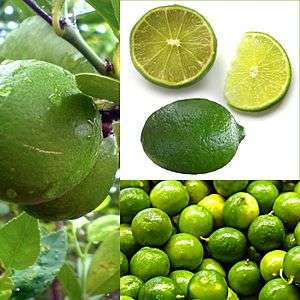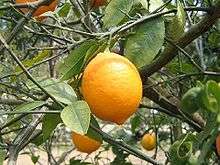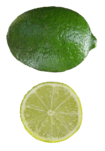Lime production in Mexico

For several decades, since at least the 1950s, Mexico has been the world's largest producer and exporter of limes,[1][2][3][4] and especially of lime oil.[2][5]
The two popular varieties of limes grown in Mexico are the Mexican or Key lime (Citrus aurantifolia) and the Persian lime (Citrus latifolia, simply called "lime" in the US); the former is of Indo–Malayan origin introduced in Mexico by the Spaniards after the 1520s,[6] while the latter, also called the Tahiti lime, was introduced from US. Persian lime production in Mexico caters specifically to the US market; a substantial increase in production has been attributed to the North American Free Trade Agreement.[7] Lime production in Mexico has also expanded consequent to the increase in its per capita consumption in the United States and the European Union (EU).[8]
Geographical distribution
Most limes are grown in the warmer southwest (60% of total) and southeast of the country (40%). Key limes amount to about 54% of the total lime production, and are grown in the southwestern states of Jalisco, Colima, Michoacán, Guerrero, and Oaxaca. Persian limes, about 42% of the lime production, are grown in Jalisco, Colima, Hidalgo, in micro-climates in northern Veracruz, and in the southeastern states of Tlaxcala, Chiapas, Tabasco and the Yucatan.[9][10][11] The most important lime producing states are Michoacán and Colima.[9]
Characteristics of limes grown in Mexico
Mexican lime
The Mexican lime tree, a slender tree which grows to heights of 2.0–4.0 m (6.6–13.1 ft), bears scentless flowers (with white stems and yellow anthers) that mature into fruits, singly, in pairs or in larger clusters. The fruit, which is generally 25–51 mm (0.98–2.01 in) in diameter, as it ripens, changes its peel color from green to pale-yellow. The greenish-yellow pulp of the fruit, with its inseparable 6–15 segments, is juicy and highly acidic with flavor and aroma. It has either a few or many small seeds. Though the climatic conditions under which the Mexican lime thrives is moist, with annual precipitation in the range of 2,000–3,800 mm (79–150 in) the tree is more capable of enduring drought conditions than other citrus fruit varieties. However, in excessive rainfall, trees may be infected with fungus. The Mexican lime is also more sensitive to cold than the lemon, and can be grown only in protected locations.[6]
The Mexican or Key lime has a longer shelf life than other limes, which is useful since refrigeration facilities are lacking in the country. The tree species of Indo-Malayan region was introduced to Mexico by Spaniards after 1520. Now, 2,000,000 seedling trees are reported near Colima. However, there are very few varieties of the Mexican lime, except for several spineless selections, inasmuch as there is no great variation in the wild or under cultivation.[6][7]
Persian lime

Persian limes are larger and contain more juice than Mexican limes.[7] It is an acid lime which has been developed in recent times. Its origin is inferred as a hybrid of the Mexican lime and citron.[12]
The Persian or Tahiti lime tree grows to 15–20 feet (4.6–6.1 m) height, with broad lanceolat leaves and slightly purple-tinged flowers (with no viable pollen) mostly in January. The fruit has vivid green peel till it ripens to pale-yellow. Its pulp with 10 segments of light greenish-yellow color is normally seedless.[12]
Production
The world lemon and lime production was about 10.6 million tonnes in 2010, a 15% increase over the 1996–98 level with a projected annual rate of growth of 1.1% (as against 4.4% rate of growth recorded from 1986–88 to 1996–98). Mexico, Spain, and Argentina have been the major exporters of fresh lemons.[8]
The biggest focus of Mexican citrus production is on key limes; in 2003, Mexico produced 768,000 tonnes of key limes and 235,000 tonnes of Persian limes.[10] For the 2010/11 season, Mexico forecasts that it will produce a total of 1.9 million tonnes of limes.[9] The largest importers of lime oil are the US, UK, Japan, Ireland and Belgium.[5]
In recent years, the Persian lime industry has taken off in Veracruz, dominated by large-scale producers, with over 25% of limes being produced using micro-jet irrigation or other irrigation systems, year-round in micro-climates.[9] Transportation costs from Veracruz to the US border are reported to be approximately 11,500 pesos (US$912.69) per trailer, depending on fuel prices.[9]
References
- ↑ Spiegel-Roy, Pinchas; Goldschmidt, Eliezer E. (1996). Biology of citrus. Cambridge University Press. p. 13. ISBN 978-0-521-33321-4. Retrieved 25 June 2011.
- 1 2 FAS-M. Foreign Agricultural Service, US Dept. of Agriculture. 1956. p. 30. Retrieved 25 June 2011.
- ↑ Khan, Iqrar Ahmad (29 December 2007). Citrus genetics, breeding and biotechnology. CABI. p. 2. ISBN 978-0-85199-019-4. Retrieved 25 June 2011.
- ↑ Sarris, Alexander (2003). Medium-term prospects for agricultural commodities: projections to the year 2010. Food & Agriculture Org. p. 98. ISBN 978-92-5-105077-4. Retrieved 18 June 2011.
- 1 2 Saul Julian Abarca Orozco, James E. Epperson. "The Economic Potential of the Lime-Oil Industry in Mexico" (PDF). Agcon. Retrieved 16 June 2011.
- 1 2 3 "Citrus aurantifolia Swingle". hort.purdue.edu/. Retrieved 16 June 2011.
- 1 2 3 Spreen T.H. "The Citrus industries of the United States and Mexico after NAFTA" (PDF). chapingo.mx. pp. 151–152. Retrieved 16 June 2011.
- 1 2 "Projections of World Production and Consumption of Citrus to 2010". fao.org. Retrieved 16 June 2011.
- 1 2 3 4 5 "Orange, Lemon and Lime, Grapefruit, and Frozen Concentrated Orange Juice Situation" (PDF). Chilealimentos. 12 May 2010. Retrieved 16 June 2011.
- 1 2 "THE MEXICAN LIME INDUSTRY" (PDF). Food Science and Human Nutrition Department, University of Florida. Retrieved 16 June 2011.
- ↑ "The Mexican Lime Industry" (PDF). fshn.ifas.ufl.edu/. Retrieved 16 June 2011.
- 1 2 "Tahiti Lime". hort.purdue.edu. Retrieved 16 June 2011.


.svg.png)